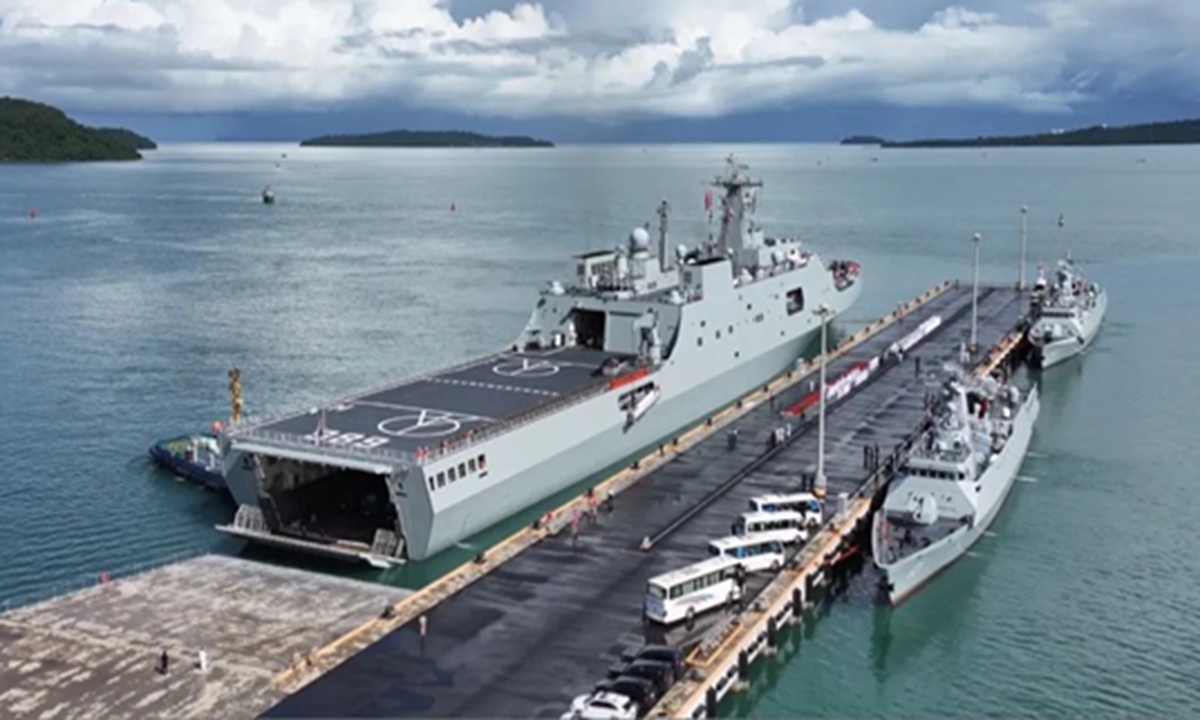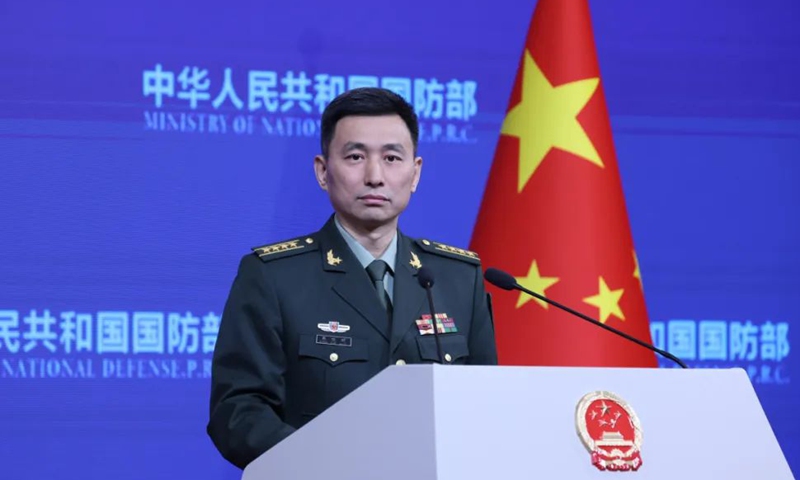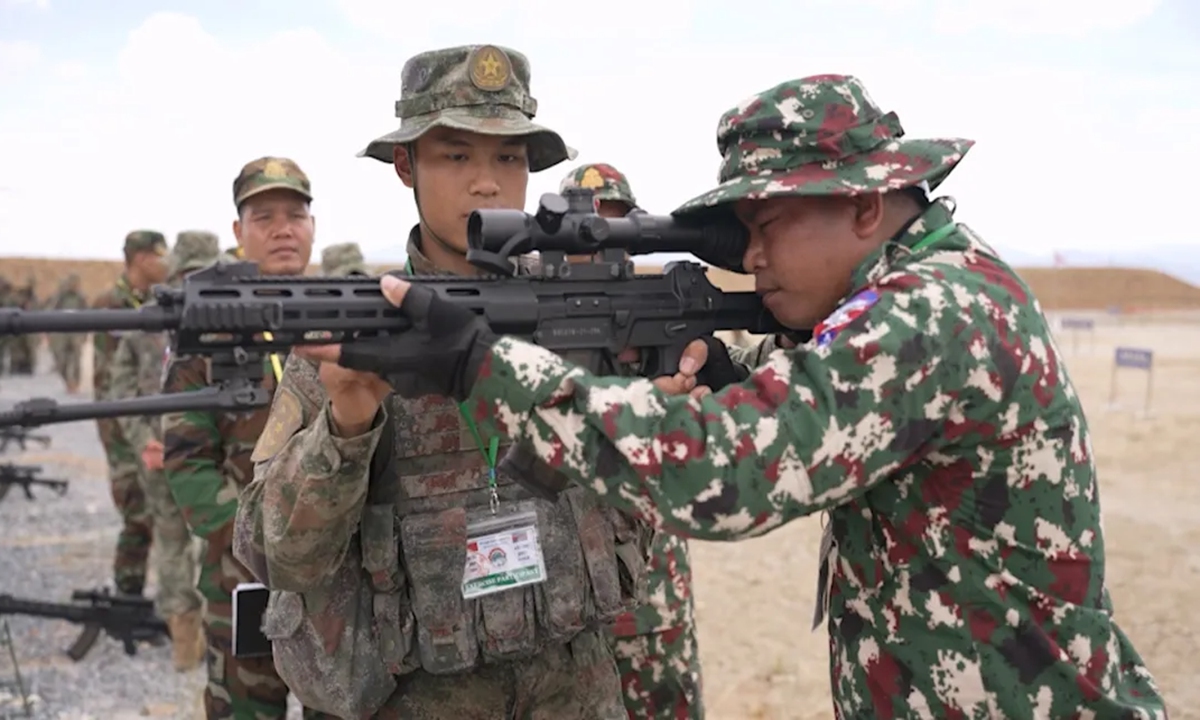China-Cambodia ‘Golden Dragon-2025’ joint drills signify deeper military co-op: expert

The Type 071 amphibious landing ship Changbaishan (left) of the Chinese People's Liberation Army (PLA) Navy arrives at Port Ream in Cambodia on May 12 ahead of the "Golden Dragon-2025" joint exercise. Photo: Screenshot from China Bugle, an official media account affiliated with the PLA news media center
After China and Cambodia launched the "Golden Dragon-2025" joint exercise at a training center on Saturday, an expert told Global Times on Sunday that with the continuous increase in participating forces and branches, the scale and scope of the joint exercise has expanded, and China's deployment of advanced unmanned combat systems signifies a deeper level of military cooperation.
Participating troops from China and Cambodia, military attachés from multiple countries stationed in Cambodia, and personnel from Cambodian government departments and armed forces attended the Saturday ceremony, according to the Chinese People's Liberation Army (PLA) Southern Theater Command.
At the opening ceremony, participating troops from both countries played and sang the national anthems of China and Cambodia. The joint command headquarters reported on the exercise plan, representatives from both sides delivered speeches, and attendees toured the participating equipment, including infantry fighting vehicles, assault vehicles, helicopters, radar systems and drones.
The joint exercise adheres to the theme of "peace, friendship and cooperation," focusing on the topics of "joint counter-terrorism and humanitarian assistance and disaster relief (HADR) operations," said the Southern Theater Command.
The PLA news and communication center updated via its Sina Weibo platform on Sunday that participating troops from China and Cambodia organized mixed-unit training, conducting exercises such as coordinated assault vehicle squad operations, rope descent, and unmanned equipment applications, which aimed to strengthen pro-fessional skills and enhance tactical coordination capabilities.
Also on Sunday, Chinese participants utilized drone swarms and First-Person View (FPV) drones, demonstrating and explaining techniques for formation flight, indoor search, and guided strike operations.
Zhang Junshe, a Chinese military affairs expert, told the Global Times on Sunday that as the participating forces and branches continue to increase, the scale and scope of the exercise have expanded.
"This exercise not only covers land-air operations but also includes sea-air operations. It encompasses counter-terrorism drills on land as well as maritime counter-terrorism and humanitarian rescue exercises. Notably, this joint exercise is the first to rely on the China-Cambodia Ream Port Joint Support and Training Center for maritime operations, which also helps improve the operational level of the joint support and training center," Zhang said.
Moreover, the scale of participating equipment has also grown. Zhang said that the exercise includes light weapons and tanks used by army soldiers, helicopters from the air force, as well as naval vessels and unmanned systems, covering a broader range of equipment.
According to the PLA Southern Theater Command, this exercise also featured deeper integration. In this regard, Zhang said this is reflected in the methods of the joint exercise.
The exercise is conducted in three phases: adaptive training, command drills and live-force exercises, aimed at gradually deepening the joint operational capabilities between the two militaries.
"The three phases of the exercise involve skills training, tactical drills and comprehensive exercises. Through these phases, the degree of running-in and adaptability between the two militaries can be progressively enhanced, thereby improving joint operational capabilities and further elevating the level of integration," Zhang said.
Zhang added that the deeper collaboration is reflected in another aspect: China has deployed advanced unmanned combat systems, including land and aerial unmanned systems and other high-tech equipment. "This indicates that mutual trust between the two militaries is high and continues to deepen, which helps further enhance their level of joint operations."
Earlier, after arriving at the designated exercise area in Cambodia, Chinese troops and their Cambodian counterparts conducted mixed grouping, detailed action coordination and adaptive training, said the Southern Theater Command.
Meanwhile, during the joint exercise, forces from both sides will intersperse cultural and sports exchanges and ship open-day events. The Chinese side will also conduct medical outreach, medicine distribution and educational donation activities to promote mutual understanding between the peoples and militaries of both countries, consolidating and elevating the ironclad friendship between China and Cambodia, the Southern Theater Command said.
The "Golden Dragon" series of joint exercises is a regular military cooperation program between China and Cambodia, having been successfully held six times previously, said the Southern Theater Command.
In a press briefing on May 8, Chinese Defense Ministry spokesperson Zhang Xiaogang announced that in mid-to-late May, the Chinese and Cambodian militaries will hold the "Golden Dragon-2025" joint exercise in Cambodia. Focusing on joint counter-terrorism and HADR operations, the exercise will be conducted both on land and at sea, as well as in relevant air spaces. Cultural and sports exchanges, and vessel open day activities will also be conducted.
This exercise will be the 7th of its kind between the Chinese and Cambodian militaries. It will facilitate practical cooperation between the two sides and contribute to the building of a China-Cambodia all-weather community with a shared future for the new era, the spokesperson said.


